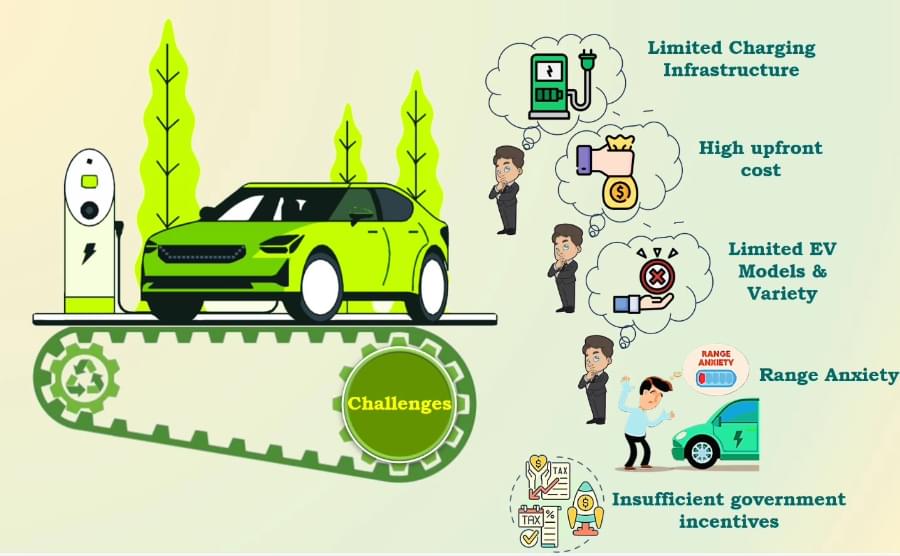Consumer Adoption and Challenges of Electric Vehicles in Canada and the USA
wordpress-Default July 3, 2024 0 COMMENTS
Electric vehicles (EVs) have emerged as a promising solution to mitigate environmental impact and reduce dependency on fossil fuels in both Canada and the United States. However, widespread adoption faces several challenges, ranging from infrastructure limitations to consumer perceptions and economic factors. In this blog, we delve into the current state of consumer adoption of EVs in Canada and the USA, exploring the challenges hindering faster uptake and the strategies being employed to overcome them.
Current State of EV Adoption
In recent years, both Canada and the USA have seen steady growth in electric vehicle adoption, driven by advancements in technology, government incentives, and increasing environmental awareness among consumers.
1. Government Incentives: Governments at federal, provincial, and state levels have implemented various incentives to encourage EV adoption. These include rebates, tax credits, and grants for purchasing EVs, as well as funding for EV charging infrastructure development. For instance, in Canada, provinces like British Columbia and Quebec offer significant rebates for EV buyers, while in the USA, federal tax credits and state incentives like those in California have been crucial in boosting EV sales.
2. Technological Advancements: Advances in battery technology have significantly improved the range and performance of EVs, making them more attractive to consumers. Tesla’s Model 3, for example, has become one of the best-selling EVs in North America due to its long range and fast charging capabilities.
3. Environmental Awareness: Growing concerns about climate change and air quality have prompted consumers to consider cleaner transportation options. EVs are seen as a sustainable alternative to internal combustion engine vehicles, emitting zero tailpipe emissions and reducing greenhouse gas emissions.
Despite these positive trends, several challenges remain that hinder broader consumer adoption of electric vehicles in both countries.
Challenges to EV Adoption
1. Range Anxiety: One of the primary concerns among potential EV buyers is range anxiety – the fear of running out of battery charge before reaching a charging station. While advancements in battery technology have extended the range of EVs, the perception of limited range persists, especially for long-distance travel or in regions with sparse charging infrastructure.
2. Charging Infrastructure: The availability and accessibility of EV charging stations play a crucial role in consumer adoption. Urban areas typically have more charging points, but rural and remote regions often lack adequate infrastructure. Installing charging stations is costly and requires cooperation between governments, utilities, and private companies to expand the network effectively.
3. Cost of EVs: Although the upfront cost of EVs has decreased in recent years, they still tend to be more expensive than traditional gasoline vehicles. Even with government incentives, the initial purchase price remains a barrier for many consumers. Additionally, concerns about the resale value of EVs and the cost of replacing batteries contribute to perceived higher ownership costs.
4. Lack of Model Diversity: While the EV market is expanding, the variety of available models compared to traditional vehicles is still limited. Consumers may find it challenging to find an EV that meets their specific needs in terms of size, performance, and features, which can deter potential buyers from making the switch.
5. Consumer Education: There is a need for extensive consumer education regarding the benefits and practicalities of owning an EV. Many potential buyers are unfamiliar with EV technology, charging options, and maintenance requirements. Educating consumers about the long-term savings on fuel and maintenance costs, as well as the environmental benefits, can help alleviate concerns and increase confidence in EV ownership.
Strategies and Solutions
Governments, automakers, and other stakeholders are actively addressing these challenges to accelerate EV adoption.
1. Infrastructure Investment: Governments are investing in expanding the EV charging network, particularly along highways and in rural areas. Initiatives such as Canada’s Zero-Emission Vehicle Infrastructure Program and various state-level programs in the USA aim to increase the number of charging stations and improve accessibility.
2. Incentives and Subsidies: Continued financial incentives, such as rebates and tax credits, help reduce the upfront cost of EVs and make them more affordable for consumers. Governments are also exploring innovative financing options and grants to support the development of charging infrastructure.
3. Technology and Innovation: Automakers are continually innovating to improve EV technology, including battery efficiency, charging speed, and vehicle performance. The introduction of more affordable models with longer ranges, like the Chevrolet Bolt and Nissan Leaf, broadens consumer choice and accessibility.
4. Public Awareness Campaigns: Educational campaigns and outreach efforts are essential to dispel myths about EVs and inform consumers about their benefits. Partnerships between automakers, utilities, and environmental organizations help promote EV adoption through workshops, test drives, and community events.
5. Collaboration and Standardization: Collaboration between governments, automakers, utilities, and other stakeholders is crucial for developing standardized protocols and regulations for EV infrastructure. This cooperation ensures interoperability between different charging networks and promotes a seamless experience for EV owners.
While electric vehicles offer a sustainable and efficient mode of transportation, several challenges must be overcome to achieve widespread adoption in Canada and the USA. By addressing range anxiety, expanding charging infrastructure, reducing costs, diversifying vehicle models, and educating consumers, stakeholders can accelerate the transition to electric mobility. Continued collaboration and innovation will play a pivotal role in shaping the future of EV adoption, paving the way for a cleaner and more sustainable transportation system in North America.
As awareness grows and technology advances, the prospect of electric vehicles becoming mainstream in Canada and the USA appears increasingly promising. With concerted efforts and strategic investments, the transition to electric mobility can contribute significantly to reducing emissions, improving air quality, and creating a more sustainable future for generations to come.








